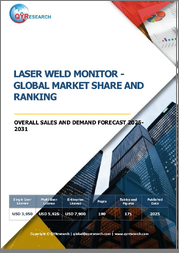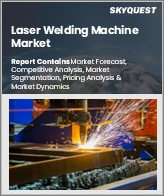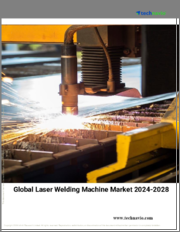
|
시장보고서
상품코드
1472084
세계의 레이저 용접 시스템 시장 규모 조사 및 예측 : 레이저 유형별, 출력별, 용도별, 지역별 분석(2023-2030년)Global Laser Welding System Market Size study & Forecast, by Laser Type (Gas Laser, Solid-State, Fiber, Others), by Power, by Application and Regional Analysis, 2023-2030 |
||||||
세계의 레이저 용접 시스템 시장은 2022년에 약 33억 1,000만 달러에 달하며, 예측 기간인 2023-2030년에는 6.90% 이상의 건전한 성장률로 성장할 것으로 예측되고 있습니다.
레이저 용접 시스템은 레이저 빔을 이용하여 용접 공정으로 재료를 접합하는 기술입니다. 레이저 용접은 레이저의 강력한 집광 빔을 사용하여 재료를 녹이고 융합하여 견고하고 정밀한 접합을 달성합니다. 레이저 빔은 집중된 열을 공급하기 때문에 용접 영역을 좁게 제어할 수 있습니다. 레이저 용접 시스템에는 파이버 레이저, CO2 레이저, 고체 레이저 등 다양한 유형의 레이저를 사용할 수 있습니다. 또한 자동차 제조 수요 증가, 항공우주 산업의 채택 증가, 자동화 및 인더스트리 4.0 증가, 용접 정확도 및 품질에 대한 수요 증가는 예측 기간 인 2023년에서 2030년 사이에 시장에 유리한 수요를 창출할 것으로 예상됩니다.
또한 자동차 산업은 레이저 용접 시스템에 대한 수요에 크게 기여하고 있습니다. 이 기술은 차체 부품, 섀시 부품, 배기 시스템 등 자동차 제조 공정에서 부품을 결합하는 데 널리 사용됩니다. Statista에 따르면 2020년 미국의 자동차·부품 제조업 총생산고는 6,442억 달러로, 2022년에는 8,630억 달러에 달합니다. 그 결과, 자동차 및 부품 제조의 성장은 시장에 유리한 수요를 창출할 것으로 예상됩니다. 또한 파이버 레이저 시스템의 기술 발전과 경량 소재에 대한 수요 증가는 시장에 유리한 기회를 창출할 것으로 예상됩니다. 그러나 높은 초기 비용은 2023-2030년 예측 기간 중 시장 성장을 저해할 것으로 보입니다.
세계의 레이저 용접 시스템 시장 조사에서 고려한 주요 지역은 아시아태평양, 북미, 유럽, 라틴아메리카, 중동 및 아프리카 등입니다. 북미는 자동차, 항공우주, 전자 등 제조업의 성장, 레이저 용접 기술의 지속적인 발전, 주요 시장 기업의 존재, 자동차 분야에서의 채택 증가로 인해 2022년 시장을 장악했습니다. 반면, 아시아태평양은 자동차 산업 확장, 항공우주 분야 투자 증가, 인프라 개발, 정부 지원책 및 정책 등의 요인으로 인해 예측 기간 중 가장 빠른 성장률을 보일 것으로 예상됩니다.
본 조사의 목적은 최근 다양한 부문과 국가의 시장 규모를 정의하고, 향후 수년간 시장 규모를 예측하는 것입니다. 조사 대상국에서 산업의 질적·양적 측면 양측을 포함시키도록 설계되고 있습니다.
또한 시장의 향후 성장을 규정하는 촉진요인 및 과제 등의 중요한 측면에 관한 상세 정보도 제공하고 있습니다. 또한 주요 기업의 경쟁 구도 및 제품 제공의 상세 분석과 함께 이해관계자가 투자하기 위한 미시적 시장에서의 잠재적 기회도 통합하고 있습니다.
목차
제1장 주요 요약
제2장 세계의 레이저 용접 시스템 시장 정의와 범위
- 조사 목적
- 시장의 정의와 범위
- 업계의 진화
- 조사 범위
- 조사 대상년
- 통화 환산율
제3장 세계의 레이저 용접 시스템 시장 역학
- 레이저 용접 시스템 시장의 영향 분석(2020-2030년)
- 시장 촉진요인
- 자동차 제조에서 수요의 증가
- 항공우주 산업에서 채택의 증가
- 자동화와 인더스트리 4.0의 부상
- 용접 정도와 품질에 대한 수요의 증가
- 시장이 해결해야 할 과제
- 레이저 용접 시스템의 높은 초기 비용
- 시장 기회
- 파이버 레이저 시스템의 기술 진보
- 경량 재료에 대한 수요의 증가
- 시장 촉진요인
제4장 세계의 레이저 용접 시스템 시장 산업 분석
- Porter's Five Forces 모델
- 공급 기업의 교섭력
- 구매자의 교섭력
- 신규 진출업체의 위협
- 대체품의 위협
- 경쟁 기업간 경쟁 관계
- Porter's Five Forces 영향 분석
- PEST 분석
- 정치
- 경제
- 사회
- 기술
- 환경
- 법률
- 주요 투자 기회
- 주요 성공 전략
- COVID-19 영향 분석
- 파괴적 동향
- 업계 전문가의 시점
- 애널리스트의 결론·제안
제5장 세계의 레이저 용접 시스템 시장 : 레이저 유형별
- 시장 스냅숏
- 세계의 레이저 용접 시스템 시장 : 레이저 유형별, 실적 - 잠재력 분석
- 세계의 레이저 용접 시스템 시장 추정·예측 : 레이저 유형별, 2020-2030년
- 레이저 용접 시스템 시장, 하위 부문 분석
- 가스 레이저(CO2)
- 솔리드 스테이트
- 섬유
- 기타
제6장 세계의 레이저 용접 시스템 시장 : 출력별
- 시장 스냅숏
- 세계의 레이저 용접 시스템 시장 : 출력별, 실적 - 잠재력 분석
- 세계의 레이저 용접 시스템 시장 추정·예측 : 출력별, 2020-2030년
- 레이저 용접 시스템 시장, 하위 부문 분석
- 1kW 이하
- 1.1kW 이상
제7장 세계의 레이저 용접 시스템 시장 : 용도별
- 시장 스냅숏
- 세계의 레이저 용접 시스템 시장 : 용도별, 실적 - 잠재력 분석
- 세계의 레이저 용접 시스템 시장 추정·예측 : 용도별, 2020-2030년
- 세계의 레이저 용접 시스템 시장, 하위 부문 분석
- 자동차
- 일렉트로닉스
- 항공우주
- 기타
제8장 세계의 레이저 용접 시스템 시장 : 지역별 분석
- 주요 국가
- 주요 신흥 국가
- 레이저 용접 시스템 시장, 지역별 시장 스냅숏
- 북미
- 미국
- 레이저 유형 내역 추정·예측, 2020-2030년
- 출력 내역 추정·예측, 2020-2030년
- 용도 내역 추정·예측, 2020-2030년
- 캐나다
- 미국
- 유럽의 레이저 용접 시스템 시장 스냅숏
- 영국
- 독일
- 프랑스
- 스페인
- 이탈리아
- 기타 유럽
- 아시아태평양의 레이저 용접 시스템 시장 스냅숏
- 중국
- 인도
- 일본
- 호주
- 한국
- 기타 아시아태평양
- 라틴아메리카의 레이저 용접 시스템 시장 스냅숏
- 브라질
- 멕시코
- 중동 및 아프리카
- 사우디아라비아
- 남아프리카공화국
- 기타 중동 및 아프리카
제9장 경쟁 정보
- 주요 기업의 SWOT 분석
- 주요 시장 전략
- 기업 개요
- ALPHA Laser GmbH
- 주요 정보
- 개요
- 재무(데이터의 가용성에 따름)
- 제품 개요
- 최근 동향
- LaserStar Technologies Corporation
- Amada Co., Ltd.
- Panasonic Corporation
- Coherent Corp.
- Hans Laser Technology Industry Group, Co. LTD.
- Foshan Huibaisheng Laser Technology Co., Ltd
- IRE-Polus Group
- TRUMPF Group
- Jenoptik AG
- ALPHA Laser GmbH
제10장 조사 프로세스
- 조사 프로세스
- 데이터 마이닝
- 분석
- 시장 추정
- 검증
- 출판
- 조사 속성
- 조사 전제조건
Global Laser Welding System Market is valued at approximately USD 3.31 billion in 2022 and is anticipated to grow with a healthy growth rate of more than 6.90% during the forecast period 2023-2030. Laser Welding System is a technology that utilizes laser beams to join materials together through the process of welding. In laser welding, the intense, focused beam of a laser is used to melt and fuse the materials, creating a strong and precise bond. The laser beam provides concentrated heat, allowing for a narrow and controlled welding area. Various types of lasers, such as fiber lasers, CO2 lasers, and solid-state lasers, can be used in laser welding systems. Moreover, the growing demand in automotive manufacturing, rise in adoption in the aerospace industry, rise in automation and industry 4.0, and growing demand in precision and quality of welds that anticipated to create a lucrative demand for the market during the forecast period 2023-2030.
Additionally, the automotive industry is a major contributor to the demand for laser welding systems. The technology is widely used for joining components in the automotive manufacturing process, including body parts, chassis components, and exhaust systems. Thus, the growing automotive manufacturing is anticipated to support the market growth. According to Statista, in 2020 the U.S. motor vehicles and parts manufacturing generated a gross output of USD 644.2 billion and in 2022 the number reached USD 863 billion. As a result, the growing vehicles and parts manufacturing is anticipated to create a lucrative demand for the market. Moreover, the technological advancements in fiber laser systems and growing demand for lightweight materials are anticipated to create lucrative opportunities for the market. However, the high initial cost stifles market growth throughout the forecast period of 2023-2030.
The key regions considered for the Global Laser Welding System Market study includes Asia Pacific, North America, Europe, Latin America, and Middle East & Africa. North America dominated the market in 2022 owing to the growing manufacturing industries, such as automotive, aerospace, and electronics, ongoing advancements in laser welding technology, the presence of key market players, and increasing adoption in the automotive sector. Whereas, the Asia Pacific is expected to grow with the fastest growth rate over the forecast period, owing to factors such as the growing expansion of the automotive industry, rising investments in the aerospace sector, growing infrastructure development, and supportive government initiatives and policies.
Major market player included in this report are:
- ALPHA Laser GmbH
- LaserStar Technologies Corporation
- Amada Co., Ltd.
- Panasonic Corporation
- Coherent Corp.
- Hans Laser Technology Industry Group, Co. LTD.
- Foshan Huibaisheng Laser Technology Co., Ltd
- IRE-Polus Group
- TRUMPF Group
- Jenoptik AG
Recent Developments in the Market:
- In September 2023, TRUMPF inaugurated a new regional headquarters in Hungary, marking its expansion into Southeast Europe. The lasers manufactured by TRUMPF are integral components in the production facilities of Korean car battery manufacturers operating in Hungary, catering to the European market.
Global Laser Welding System Market Report Scope:
- Historical Data - 2020 - 2021
- Base Year for Estimation - 2022
- Forecast period - 2023-2030
- Report Coverage - Revenue forecast, Company Ranking, Competitive Landscape, Growth factors, and Trends
- Segments Covered - Laser Type, Power, Application, Region
- Regional Scope - North America; Europe; Asia Pacific; Latin America; Middle East & Africa
- Customization Scope - Free report customization (equivalent up to 8 analyst's working hours) with purchase. Addition or alteration to country, regional & segment scope*
The objective of the study is to define market sizes of different segments & countries in recent years and to forecast the values to the coming years. The report is designed to incorporate both qualitative and quantitative aspects of the industry within countries involved in the study.
The report also caters detailed information about the crucial aspects such as driving factors & challenges which will define the future growth of the market. Additionally, it also incorporates potential opportunities in micro markets for stakeholders to invest along with the detailed analysis of competitive landscape and product offerings of key players. The detailed segments and sub-segment of the market are explained below:
By Laser Type:
- Gas Laser (CO2)
- Solid-State
- Fiber
- Others
By Power:
- Less than 1kW
- More than 1.1 kW
By Application:
- Automotive
- Electronics
- Aerospace
- Others
By Region:
- North America
- U.S.
- Canada
- Europe
- UK
- Germany
- France
- Spain
- Italy
- ROE
- Asia Pacific
- China
- India
- Japan
- Australia
- South Korea
- RoAPAC
- Latin America
- Brazil
- Mexico
- Middle East & Africa
- Saudi Arabia
- South Africa
- Rest of Middle East & Africa
Table of Contents
Chapter 1.Executive Summary
- 1.1.Market Snapshot
- 1.2.Global & Segmental Market Estimates & Forecasts, 2020-2030 (USD Billion)
- 1.2.1.Laser Welding System Market, by Region, 2020-2030 (USD Billion)
- 1.2.2.Laser Welding System Market, by Laser Type, 2020-2030 (USD Billion)
- 1.2.3.Laser Welding System Market, by Power, 2020-2030 (USD Billion)
- 1.2.4.Laser Welding System Market, by Application, 2020-2030 (USD Billion)
- 1.3.Key Trends
- 1.4.Estimation Methodology
- 1.5.Research Assumption
Chapter 2.Global Laser Welding System Market Definition and Scope
- 2.1.Objective of the Study
- 2.2.Market Definition & Scope
- 2.2.1.Industry Evolution
- 2.2.2.Scope of the Study
- 2.3.Years Considered for the Study
- 2.4.Currency Conversion Rates
Chapter 3.Global Laser Welding System Market Dynamics
- 3.1.Laser Welding System Market Impact Analysis (2020-2030)
- 3.1.1.Market Drivers
- 3.1.1.1.Growing demand in automotive manufacturing
- 3.1.1.2.Rise in adoption in aerospace industry
- 3.1.1.3.Rise in automation and industry 4.0
- 3.1.1.4.Growing demand in precision and quality of welds
- 3.1.2.Market Challenges
- 3.1.2.1.High initial cost of laser welding systems
- 3.1.3.Market Opportunities
- 3.1.3.1.Technological advancements in fiber laser system
- 3.1.3.2.Growing demand for lightweight materials
- 3.1.1.Market Drivers
Chapter 4.Global Laser Welding System Market Industry Analysis
- 4.1.Porter's 5 Force Model
- 4.1.1.Bargaining Power of Suppliers
- 4.1.2.Bargaining Power of Buyers
- 4.1.3.Threat of New Entrants
- 4.1.4.Threat of Substitutes
- 4.1.5.Competitive Rivalry
- 4.2.Porter's 5 Force Impact Analysis
- 4.3.PEST Analysis
- 4.3.1.Political
- 4.3.2.Economical
- 4.3.3.Social
- 4.3.4.Technological
- 4.3.5.Environmental
- 4.3.6.Legal
- 4.4.Top investment opportunity
- 4.5.Top winning strategies
- 4.6.COVID-19 Impact Analysis
- 4.7.Disruptive Trends
- 4.8.Industry Expert Perspective
- 4.9.Analyst Recommendation & Conclusion
Chapter 5.Global Laser Welding System Market, by Laser Type
- 5.1.Market Snapshot
- 5.2.Global Laser Welding System Market by Laser Type, Performance - Potential Analysis
- 5.3.Global Laser Welding System Market Estimates & Forecasts by Laser Type 2020-2030 (USD Billion)
- 5.4.Laser Welding System Market, Sub Segment Analysis
- 5.4.1. Gas Laser (CO2)
- 5.4.2.Solid-State
- 5.4.3.Fiber
- 5.4.4.Others
Chapter 6.Global Laser Welding System Market, by Power
- 6.1.Market Snapshot
- 6.2.Global Laser Welding System Market by Power, Performance - Potential Analysis
- 6.3.Global Laser Welding System Market Estimates & Forecasts by Power 2020-2030 (USD Billion)
- 6.4.Laser Welding System Market, Sub Segment Analysis
- 6.4.1. Less than 1kW
- 6.4.2.More than 1.1 kW
Chapter 7.Global Laser Welding System Market, by Application
- 7.1.Market Snapshot
- 7.2.Global Laser Welding System Market by Application, Performance - Potential Analysis
- 7.3.Global Laser Welding System Market Estimates & Forecasts by Application 2020-2030 (USD Billion)
- 7.4.Laser Welding System Market, Sub Segment Analysis
- 7.4.1. Automotive
- 7.4.2.Electronics
- 7.4.3.Aerospace
- 7.4.4.Others
Chapter 8.Global Laser Welding System Market, Regional Analysis
- 8.1.Top Leading Countries
- 8.2.Top Emerging Countries
- 8.3.Laser Welding System Market, Regional Market Snapshot
- 8.4.North America Laser Welding System Market
- 8.4.1.U.S. Laser Welding System Market
- 8.4.1.1.Laser Type breakdown estimates & forecasts, 2020-2030
- 8.4.1.2.Power breakdown estimates & forecasts, 2020-2030
- 8.4.1.3.Application breakdown estimates & forecasts, 2020-2030
- 8.4.2.Canada Laser Welding System Market
- 8.4.1.U.S. Laser Welding System Market
- 8.5.Europe Laser Welding System Market Snapshot
- 8.5.1.U.K. Laser Welding System Market
- 8.5.2.Germany Laser Welding System Market
- 8.5.3.France Laser Welding System Market
- 8.5.4.Spain Laser Welding System Market
- 8.5.5.Italy Laser Welding System Market
- 8.5.6.Rest of Europe Laser Welding System Market
- 8.6.Asia-Pacific Laser Welding System Market Snapshot
- 8.6.1.China Laser Welding System Market
- 8.6.2.India Laser Welding System Market
- 8.6.3.Japan Laser Welding System Market
- 8.6.4.Australia Laser Welding System Market
- 8.6.5.South Korea Laser Welding System Market
- 8.6.6.Rest of Asia Pacific Laser Welding System Market
- 8.7.Latin America Laser Welding System Market Snapshot
- 8.7.1.Brazil Laser Welding System Market
- 8.7.2.Mexico Laser Welding System Market
- 8.8.Middle East & Africa Laser Welding System Market
- 8.8.1.Saudi Arabia Laser Welding System Market
- 8.8.2.South Africa Laser Welding System Market
- 8.8.3.Rest of Middle East & Africa Laser Welding System Market
Chapter 9.Competitive Intelligence
- 9.1.Key Company SWOT Analysis
- 9.2.Top Market Strategies
- 9.3.Company Profiles
- 9.3.1. ALPHA Laser GmbH
- 9.3.1.1.Key Information
- 9.3.1.2.Overview
- 9.3.1.3.Financial (Subject to Data Availability)
- 9.3.1.4.Product Summary
- 9.3.1.5.Recent Developments
- 9.3.2. LaserStar Technologies Corporation
- 9.3.3.Amada Co., Ltd.
- 9.3.4.Panasonic Corporation
- 9.3.5.Coherent Corp.
- 9.3.6.Hans Laser Technology Industry Group, Co. LTD.
- 9.3.7.Foshan Huibaisheng Laser Technology Co., Ltd
- 9.3.8.IRE-Polus Group
- 9.3.9.TRUMPF Group
- 9.3.10.Jenoptik AG
- 9.3.1. ALPHA Laser GmbH
Chapter 10.Research Process
- 10.1.Research Process
- 10.1.1.Data Mining
- 10.1.2.Analysis
- 10.1.3.Market Estimation
- 10.1.4.Validation
- 10.1.5.Publishing
- 10.2.Research Attributes
- 10.3.Research Assumption



















